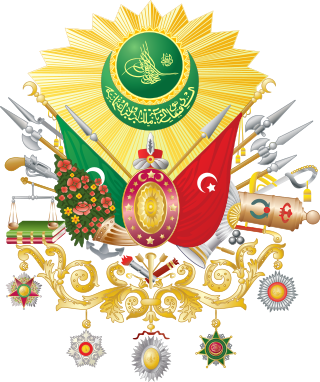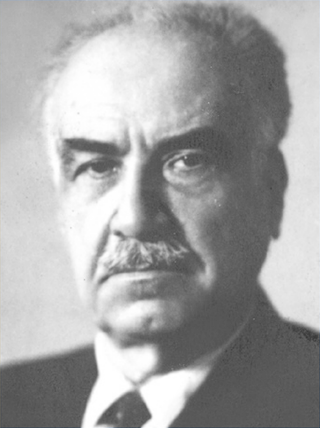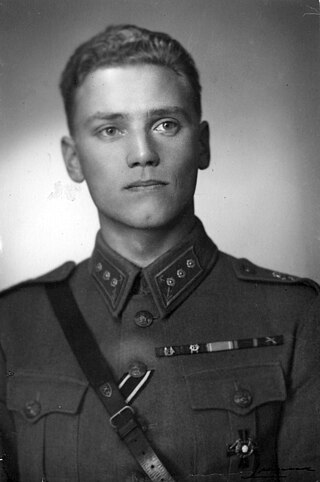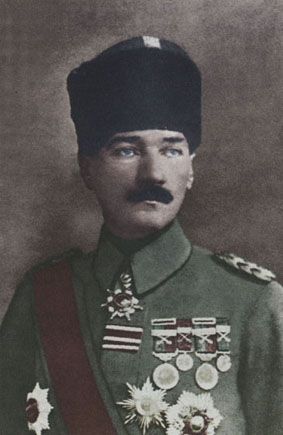Sources
- ↑ Erik Jan Zürcher, The Unionist Factor: The Role of the Committee of Union and Progress in the Turkish National Movement, 1905-1926, BRILL, 1984, ISBN 978-90-04-07262-6, p. 64.
| Military ranks of the Ottoman Empire |
|---|
| Officers |
| Non-commissioned officers |
| Historical military ranks of Egypt |
|---|
| Officers |
| Others |
Kolağası (also written as Kol Ağası, Kol Aghasi) was a military rank of the Ottoman Army. It corresponds to a Senior Captain or an Adjutant Major. [1] Kol Ağası is a compound word composed of Kol (column in Turkish) and Ağa (chief in Turkish).
The rank was junior to the rank Binbaşı , and senior to the rank Yüzbaşı (Captain) in the Ottoman Army.
Despite being a single rank, Kolağası was divided in two: Sağ Kolağası (Kolağası of the Right Flank) and Sol Kolağası (Kolağası of the Left Flank). Sağ Kolağası was senior to Sol Kolağası. After the rank of Yüzbaşı (Captain), an officer had to first become Sol Kolağası, before becoming Sağ Kolağası.

The military of the Ottoman Empire was the armed forces of the Ottoman Empire.

Mustafa Fevzi Çakmak was a Turkish field marshal (Mareşal) and politician. He served as the Chief of General Staff from 1918 and 1919 and later the Minister of War of the Ottoman Empire in 1920. He later joined the provisional Government of the Grand National Assembly and became the Deputy Prime Minister, Minister of National Defense and later as the Prime Minister of Turkey from 1921 to 1922. He was the second Chief of the General Staff of the provisional Ankara Government and the first Chief of the General Staff of the Republic of Turkey.
Ottoman court was the culture that evolved around the court of the Ottoman Empire.

The army rank of captain is a commissioned officer rank historically corresponding to the command of a company of soldiers. The rank is also used by some air forces and marine forces, but usually refers to a more senior officer. Today, a captain is typically either the commander or second-in-command of a company or artillery battery. In the Chinese People's Liberation Army, a captain may also command a company, or be the second-in-command of a battalion.

Muavenet-i Milliye or Muâvenet-i Millîye was a destroyer built for the Ottoman Navy prior to World War I. The ship is most notable for sinking the British pre-dreadnought battleship Goliath during the Dardanelles Campaign in World War I.
Mirliva or Mîr-i livâ was a military rank of the Ottoman Army and Navy. It corresponds to a brigadier general in the modern Turkish Army. Mirliva is a compound word composed of Mir (commander) and Liva. The rank was junior to the Ferik and superior to the rank Miralay (Colonel) in the Ottoman Army and the pre-1935 Turkish Army.

Mustafa Kemal Atatürk was a field marshal, revolutionary statesman, and founder of the Republic of Turkey as well as its first president. Mustafa Kemal Atatürk's military career explains his life between graduation from Ottoman War College in Istanbul as a lieutenant in 1905 to his resignation from the Ottoman Army on 8 July 1919, as well as his military leadership throughout the subsequent Turkish War of Independence.

Hasan Izzet Pasha was a Turkish general of the Ottoman Empire.

Hüseyin Avni Bey was the commander of the 57th Infantry Regiment of the Ottoman Army at the Battle of Gallipoli during which he led a counterattack that successfully stabilized the right flank of the Ottoman defences on the 25 April 1915.

General Hayrullah Fişek (1885–1975) was a career officer in the Ottoman Army and the Turkish Army.
Birinci ferik or ferik-i evvel was a military rank of the Ottoman Army. The title means "First Ferik" and was senior to a Ferik and junior only to the Müşir.
This list includes fleet organisations of the Ottoman Navy during the Italo-Turkish War.
The Ottoman Military College or Imperial Military Staff College or Ottoman Army War College, was a two-year military staff college of the Ottoman Empire. It was located in İstanbul. Its mission was to educate staff officers for the Ottoman Army.
Miralay or Mîr-i alay was a military rank of the Ottoman Army and Navy. The modern Turkish equivalent is Albay, meaning Colonel. Miralay is a compound word composed of Mir (commander) and Alay (regiment).

Süleyman Askerî Bey, also known as Suleyman Askeri, Sulayman Askari, Sulaiman al-Askari and unofficially known as Suleyman Askeri Pasha, was a military officer who served in the Ottoman Army. Askerî was of Circassian descent and co founder of the Teşkilât-ı Mahsusa, a group involved in guerilla warfare.

The kizlar agha, formally the agha of the House of Felicity, was the head of the eunuchs who guarded the Ottoman Imperial Harem in Constantinople.
The military ranks of the Ottoman Empire may be visually identified by the military insignia used during the Military of the Ottoman Empire.
Aghasi or Aghassi may refer to:

Mehmed Şükrü Pasha was a general in the Ottoman Army.